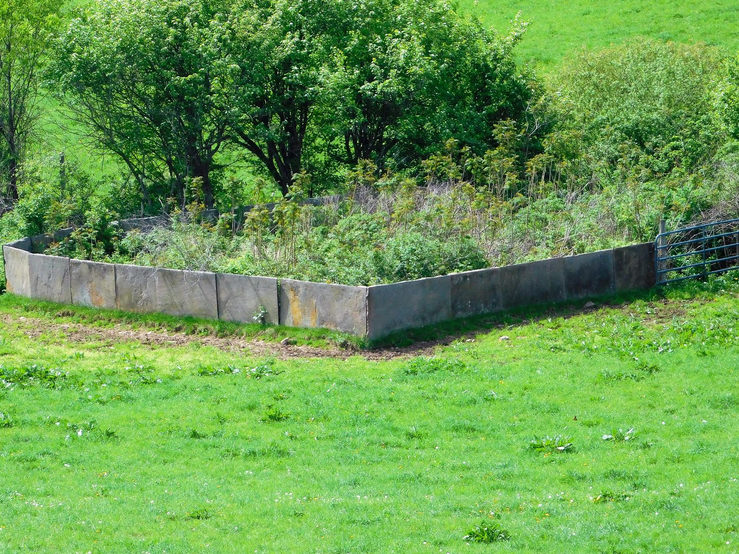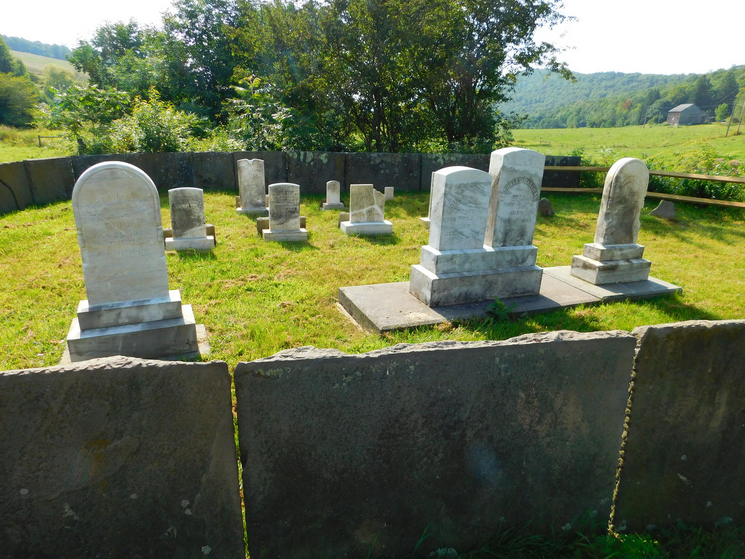Wakeman Cemetery
The year is 1808. Eliphalet Wakeman has just signed a deed purchasing 150 acres. The land was part of Lot 61 of the Walton Patent along Third Brook, northwest of Walton. This was to become the Wakeman homestead for the next 100 years. It is the place where he raised his family and where he and his wife, as well as some of his children and grandchildren, are buried.
Eliphalet was born in 1781 in Connecticut to Epaphras Wakeman and Eunice Nichols. In 1805 or 1806, Eliphalet married Eunice Gould. History tells us that Epaphras was an early pioneer, living in an area of south Walton called the “Den” and that when he had moved to New York from Connecticut, he brought most of his children with him.
Life must have been hard for Eliphalet and Eunice, but between 1807 and 1828 they had nine children, who helped on the farm. In 1835, their 22-year-old son, Henry, died from a falling tree that he was cutting. He was buried on the farm next to the creek with a simple marble tablet marking his grave. It appears that he was not alone, as nearby are three unmarked fieldstone graves. We have no idea who they are or when they were buried there.
Death struck again 24 years later in 1859 when their married daughter, Peninah Barlow, died. A newspaper article mentions that she was praised as a school teacher and an accomplished spinner and weaver. Her husband, Joseph Barlow, experienced the loss of their two daughters, Beulah and Camilla, respectively in December 1861 and early January 1862, due to diphtheria. Joseph and Peninah lost a daughter in 1844, as well.
Eliphalet Sr. passed away in 1863 according to his gravestone, but other sources show the death in 1868.
In 1864 Joseph married Sarah B. Gosper. They lost an infant son in 1866.
This was an unbelievable decade of death for the Wakeman family, with the final loss of Eliphalet’s wife, Eunice, who died in 1869.
An examination of Eliphalet’s last will and testament shows he left the use of his house to his wife as long as she remained his widow. In addition, a farm was left to his son Nathan. The farm homestead he was currently living on was to be equally divided between his sons Eliphalet Jr. and Jesse; $200 was left to each of his four daughters.

Wakeman Cemetery before restoration
Joseph Barlow died in 1873. Eliphalet Jr. followed him in 1880, leaving his share of the family homestead to his brother Jesse. Eliphalet had married Sarah Teed in 1872. At the time of his death, she was only 34 years old, and it seems she continued her life elsewhere. Jesse never married; census records show he had always lived at the Wakeman homestead. In 1899, Jesse was assaulted, gagged and robbed of a large sum of money. After that, he boarded up the house and continued to live his life nearby in Northfield where he procured room and board until his death. He continued to farm, in addition to being a careful businessman dealing in cows and sheep until his death in 1906. Now things get interesting: he did not leave a will and his estate was contested and had to be resolved at the Appellate level of the Supreme Court (William O. Northup v. George O. Mead and Edwin Wakeman.)
At the time of his death, he had not paid any room or board at Mrs. Hannah White’s where he had been living, so she was seeking compensation. In another situation, Jesse had sold a farm he owned to a couple. They ran into financial difficulties and approached Jesse about their problems. They recalled he told them not to worry, that he would take care of them and would be deeded the farm, but the couple did not receive the deed prior to Jesse’s death. The witness accounts in this court case made for some interesting reading of the lengthy affair and gives insight into the life of Jesse Wakeman and in general, life for people at that time.

Wakeman Cemetery after cleanup
In the spring of 2018, Tina saw a notice on the Delaware County NY Genealogy and History Site that Nathan Smith was seeking help to restore a lost graveyard on his father-in-law’s farm. We contacted him and he put us in touch with his in-laws, Gordon and Karin Fletcher. The cemetery was called Wakeman Cemetery. We met Gordon and hopped on his 4-wheeler and rode off into his pasture.
Their house sits on a knoll and overlooks Third Brook and has been in the Fletcher family since 1947. As we looked across the pasture, we could see what appeared to be a livestock corral but as we drew closer, we saw it was actually a stone fence and the cemetery was within it. This fence was amazing, made from bluestone slabs set on edge, almost four feet tall, four to nine feet long and four inches thick. We had never seen anything like this before.
The court proceedings tipped us off as to when this stone fence may have been built. Testimony by a witness said he had helped Jesse Wakeman when they fixed over the graveyard for about three weeks between 1894 and 1899. We feel sure this is when the stone fence was erected.
The cemetery was in atrocious condition. Trees, shrubs, grapevines, multi-flora rose, goldenrod and berry briers engulfed the whole enclosure. To make matters worse, two floods had sent water through the cemetery and every gravestone was down. We knew this project was going to be a challenge if we took on.
With Gordon’s permission and Karin’s list of burials, we set to work. Some gravestones were broken, others – and their bases – were totally buried. On special occasions, a bald eagle soared overhead. It was a quiet, peaceful setting to work in with the gently flowing brook nearby.
For a long time, we wondered about five vertical slabs of stone sticking up near the gravestones. We had never seen this done before, but apparently they were designed to sit behind the gravestones and their bases as a decorative element. It took us three years but with our the efforts and those of Gordon, Karin and Nate, we were able to restore the cemetery to a level it had not seen in years.
Everyone mentioned in this article is buried there: Eliphalet, his wife Eunice, four of their children – Henry, Peninah, Eliphalet Jr., and Jesse – two grandchildren – Beulah, Camilla, their son-in-law Joseph Barlow and his infant son.
It is interesting to note that the original burial list we obtained from Karin included Krug, Frederick died Feb. 12, 1885 age 79 in Hamden, New York and Krug, Mrs. (Marinda) wife of Frederick died July 7, 1850 age 28. We didn’t find any gravestones with those names but we did find a footstone with the initials M.K. Further investigation revealed an obituary for Frederick Krug stating his “burial was on the Jesse Wakeman farm where his wife was previously buried.” It appears they once had been buried in the Wakeman Cemetery but at some point in time they had been dug up and reinterred at the Walton Cemetery where we now find their gravestone.
To commemorate this renewal, we received a grant for a William G. Pomeroy Historical Marker. This sign will stand at the corner of Fletcher Road and state Highway 206. Gordon and Karin invite everyone for the unveiling of this new historical marker as well as a tour of this restored cemetery. The date for this sign dedication and cemetery tour will be published in The Reporter.
The Wakeman Cemetery is on private land and requires permission to visit but Gordon and Karin proudly encourage people to see this restored piece of history.
June 29, 2022
